The choice of greenhouses: types and characteristics
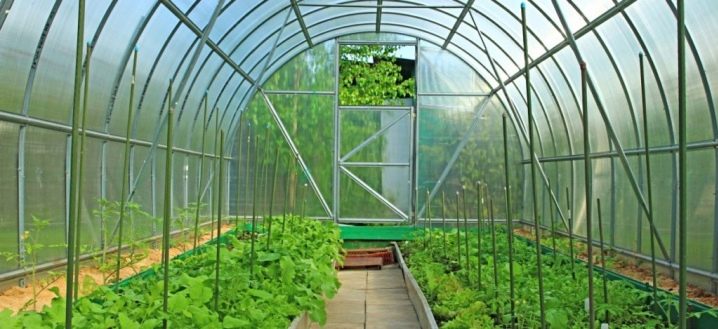
Our grandparents also tried to build structures in their gardens that help to grow a good harvest and protect it from the vagaries of nature. These were clumsy greenhouses made from scrap materials such as old window frames and old metal pipes. Today, on the market, you can find ultra-modern products equipped with mechanical irrigation and air conditioning systems.
To figure out which of them are right for you, a detailed analysis of all existing types of greenhouses today will help.
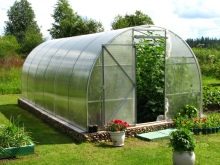
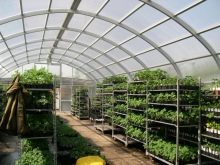
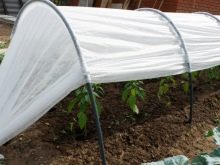
Views
All greenhouses can be classified according to several characteristics:
- By location method. Two main types are distinguished here: adjoining and free-standing. Each has its own pros and cons. For example, the first ones are easier to build and lay all the necessary communications to them. In addition, it is possible to equip the entrance to the greenhouse directly from the house. It turns out a kind of greenhouse or even a winter garden. The advantages of freestanding structures include a relatively large choice for the location of their installation, the illumination of the greenhouse from all sides and the freedom in choosing the shape and size.
By the way, when determining these parameters, you should take into account not only your own wishes, but also what crops you are going to grow (peppers, tomatoes or exotic fruits) and in what quantity.
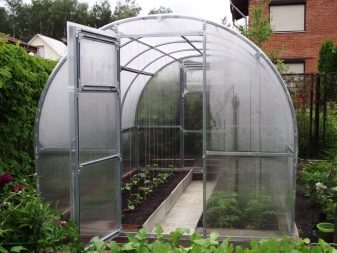
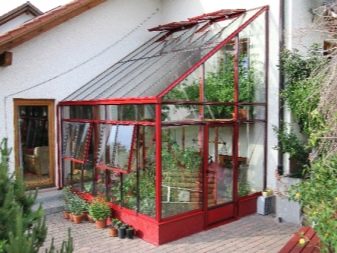
- By the construction method. According to this type, temporary and capital structures are distinguished. The latter are more reliable and durable. There is no need to clean and rebuild them every season. The downside is the need to fill the foundation and the inability to move the greenhouse to another place. The temporary greenhouse is devoid of such shortcomings, but is much inferior to the capital one in terms of reliability. In addition, this design does not imply mechanical irrigation and lighting systems. Indeed, for the next season, you can move it to another place or not install it at all.
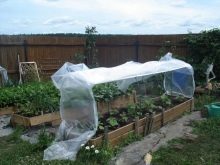
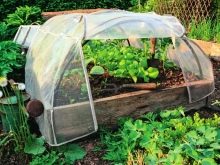
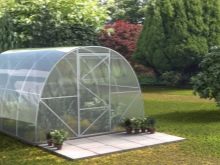
- By the height of the ground. If you do not plan to install a capital structure, but you really want to get early seedlings, then you can use a buried greenhouse. Dig a hole of the required size and fill the bottom with soil. After planting the seeds, cover everything with foil. With this arrangement, the soil freezes much less and gives early shoots. The second type includes ground greenhouses. These are, in fact, structures made of film or other materials, which are installed directly above the bed without recesses and any foundation.

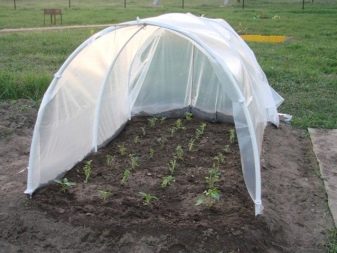
- By type of construction. There are a fairly large number of types of greenhouses that differ directly in the design itself. It can be:
- Arched or tunnel type. They are a tunnel made of metal or other bases covered with special materials that retain heat and transmit light.
- Polygonal. Depending on the manufacturer's idea, the structure may have several edges and, accordingly, angles.
- Shed.They are mainly used in adjacent structures.
- Gable. They represent the classic form of a house with a triangular roof.
It is worth noting that regardless of whether the top of the greenhouse is in the form of a triangle or has a rounded shape, the most important thing is to ensure the unhindered drainage of rainwater. And for capital structures, there is also snow in the cold season.
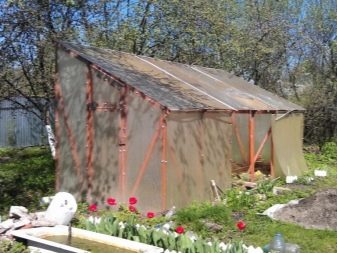
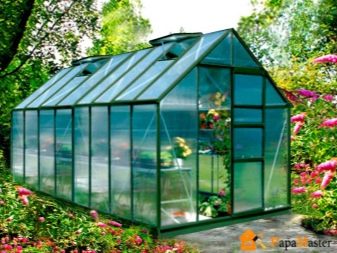


- By the way of heating. The main purpose of the greenhouse is to keep the heat inside. This can be achieved through design and thermal insulation properties. You will get the harvest in such greenhouses much earlier than in the open field. If you want to use the greenhouse for its intended purpose as long as possible during the season, you should think about additional heating. This can be done in several ways - electric or water. It all depends on the possibility of summing up communications. The easiest way is to use a bucket of embers.
- By the way the plants are grown. Depending on the types of crops, seedlings and seeds can be planted in the ground or special pots and boxes. For convenience, the latter can be placed on the shelves. This will simplify the process of caring for the plants. However, there can be some difficulties with watering, especially if you do not visit your garden every day.
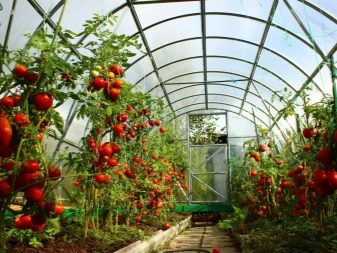
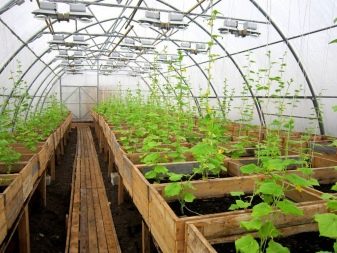

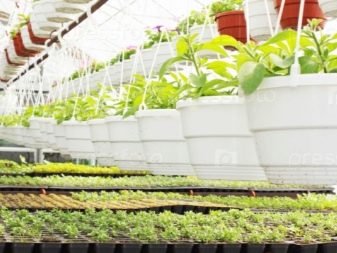
Specifications
Comparing all the options for greenhouses that exist today in terms of their main characteristics, we can come to the conclusion that cellular polycarbonate significantly outperforms its competitors. You can see this if you study in detail the indicators of the material according to the main characteristics:
Lightness of material
Compared to glass, polycarbonate is very light. This greatly simplifies the work with it and does not create additional load on the frame. If you compare it with the film, then it loses significantly, but the rest of the advantages outweigh the scales in its favor.
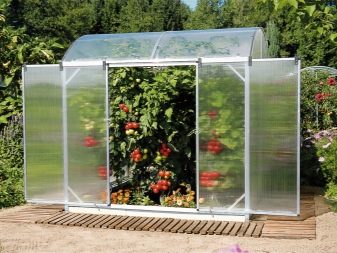
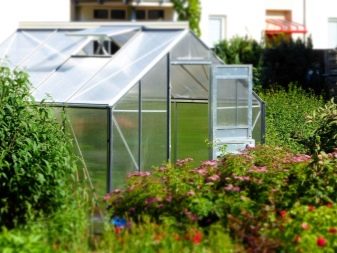
Mounting
Working with glass is very difficult. You need special skills and tools to build even a small greenhouse. Building a greenhouse in the form of a house using polycarbonate will not be difficult. But for the construction of an arched frame structure, it is better to turn to specialists.
It will not be difficult for an experienced gardener to cover the greenhouse with PVC film, but just do not forget that it can just as easily fly off or break.
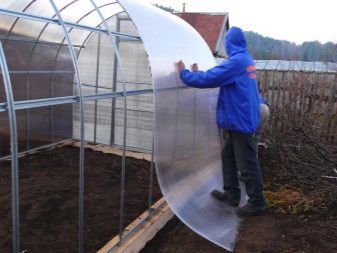
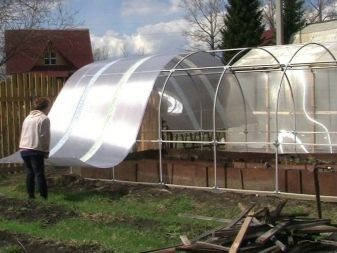
Reliability
On the one hand, glass can be classified as a fairly durable material. It is not afraid of moisture, wind, hail and even temperature extremes. But it can easily crack even from a small stone that accidentally falls into it.
It would be wrong to say that polycarbonate is not at all afraid of mechanical impact, but nevertheless it outperforms glass in this parameter. It is also resistant to the vagaries of the weather and minor mechanical stress. However, you will have to manually remove snow from the roof of the structure in winter.
The outsider here, as in many other indicators, is the film. Its density and protective properties cannot be compared with the above competitors.
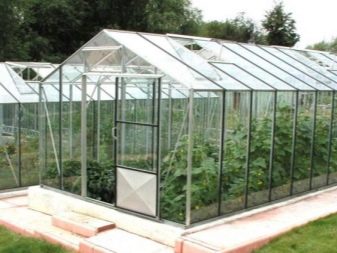
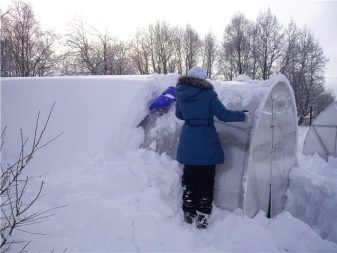
Light transmission
The leader here is glass, but this can hardly be attributed to the indisputable advantages. If the summer is hot and there is not enough ventilation, then the plants may die from the heat.
Polycarbonate can have different shades, respectively, and the light transmittance of different colors may differ. The most popular option is the transparent model. It transmits most of the light rays, while protecting from their overabundance due to a slight dimming.
In terms of light transmittance, the film can be compared with polycarbonate, but if it is a small ground greenhouse, then very often a large amount of condensation accumulates on the inside, which worsens this indicator.
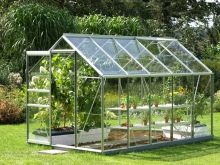
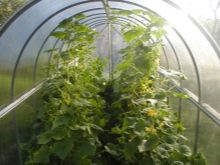
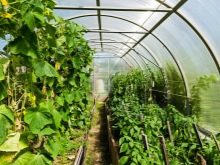
Thermal insulation
Glass greenhouses warm up very quickly, but also cool down quickly. Ie.with a sharp temperature drop, the inside of the greenhouse will also become cool very quickly. Even film options bypass it in this indicator.
Polycarbonate structures warm up rather quickly and release the accumulated heat more slowly, which allows them to maintain the optimal temperature longer without additional efforts and devices. This advantage allows the owners of polycarbonate greenhouses to collect a large harvest.
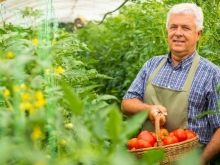
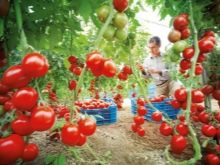

Protection of plants from ultraviolet rays
It is difficult to identify a clear leader here, since all materials provide reasonably good protection against the penetration of ultraviolet rays, the abundance of which can adversely affect crops.
Resistant to temperature extremes
Glass and polycarbonate are chosen as a covering material for stationary structures precisely because they are not afraid of frost or heat. After the end of the summer cottage season, they are left unchanged at the summer cottage. And if you equip a polycarbonate greenhouse with a heating system, then you can get a crop almost all year round.
The film is used only at the beginning of the planting season and is dismantled after harvesting in the fall. Its technical characteristics do not allow to retain and accumulate heat, moreover, it can easily crack in the cold. It will also not work to install the heater, since the material can be deformed, and in some cases it threatens to ignite it.
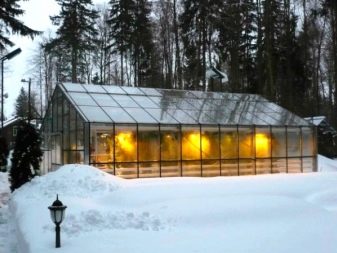
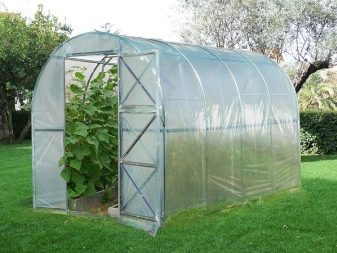
Variety of designs
Garden greenhouses come in a variety of forms. Moreover, with proper planning, even the same form can be beaten in completely different ways. For example, a "house" frame can be made with an opening top. The covering material here can be any of the described materials. Various zippers and windows can also make plant maintenance easier.
The limitation applies only to arched structures. Film and polycarbonate perfectly fit on such a frame, but not glass. Due to the lack of flexibility, it cannot be given the shape of a hemisphere.
Manufacturers of budget versions of greenhouses offer us options such as a greenhouse, which is very similar to those that we saw at our grandmothers - curved rods inserted into the ground and covered with soft covering material. Now this version has a more modern look. For example, a greenhouse with 6 sections with clips. Convenience is that the clips are securely fixed on the arches in any position. This allows you to easily open or close the structure. Such a prefabricated greenhouse can be easily removed for the winter and it does not take up much space.

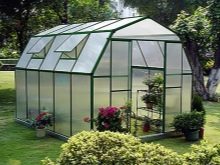
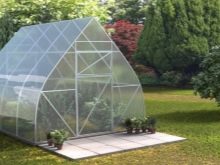
Materials (edit)
All known types of greenhouses are a frame covered with a covering material. The simplest greenhouse can be built with your own hands using thick film and curved steel rods. Manufacturers, on the other hand, offer us more complex and reliable designs made of modern materials.
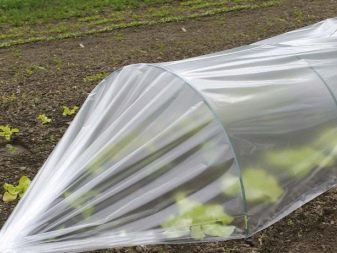

Frame
Both in production and during self-assembly, the frame can be made of metal, plastic and wood.
Wood is a traditional material for building the frame structure of a future greenhouse. If you have basic tools, you can do it yourself, which will significantly save money. And the material itself can hardly be classified as expensive. This makes the wooden frame one of the most popular and demanded among its fellows. The undeniable advantages include the environmental friendliness of this material.
As for the shortcomings, here we can note the fragility of the design. Over time, the tree loses its properties and original appearance. In most cases, it is not possible to restore it.
But it is quite possible to extend the service life. It is important to treat all frame parts annually with special protective compounds. Another disadvantage is the very limited plasticity of the wood.It is almost impossible to make beautiful arched structures out of it, so it remains to be content with the shape of the house or the lean-to option.
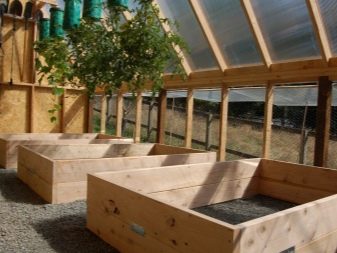



Plastic is an inexpensive material that allows manufacturers to produce complex designs that are affordable. This option can be safely chosen if you plan to install a temporary structure. For the convenience of users, even special collapsible and folding models have been created.
When self-made, plastic water pipes are quite suitable as a frame. This will allow you to save money and set the design of the desired size and shape. If one of the elements is damaged during operation, then it can be easily replaced with a new one.
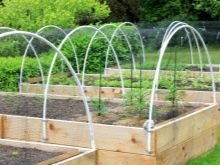
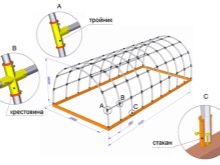
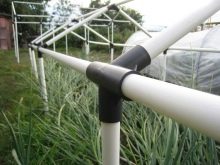
It is from plastic that it is easiest to build an arched frame. The material bends well, and its low weight makes it possible to install the structure without much effort.
This material also has a number of disadvantages that can affect the choice:
- low strength indicators, which leads to the appearance of cracks;
- not suitable for capital structures, as it does not tolerate temperature extremes;
- difficulties may arise when installing the frame to a concrete base;
- the inability to use polycarbonate as a covering material for arch-type greenhouses (due to the higher rigidity of the material in relation to the plastic frame);
- glass can also exert too much pressure on the plastic, as a result of which the structure may become unusable.
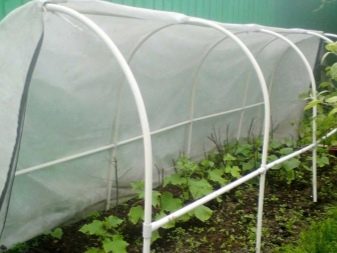
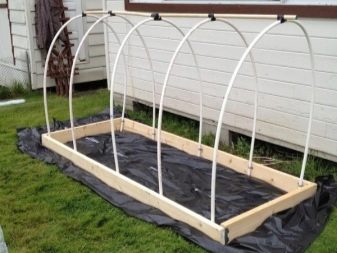
Not so long ago, an alternative material appeared on the market, from which it is also possible to make a greenhouse frame - this is fiberglass reinforcement. It differs from ordinary plastic in its increased strength, but not as flexible. And the cost of such material is much higher. That is why frames made of such reinforcement can be found quite rarely.
Metal is the most reliable and durable material for capital greenhouses. It is able to withstand both significant temperature changes and additional loads. For the winter, such a structure is not dismantled, since it is able to withstand even a thick layer of snow. Although it will still have to be thrown off, since the covering material can deform or even burst under the weight of precipitation.
The frame for the greenhouse can be made of a shaped tube, aluminum or galvanized profile. From the first, beautiful, even and strong arcs are obtained. You can also create them manually if you have such a specific tool as a pipe bender, or you can invite a specialist.
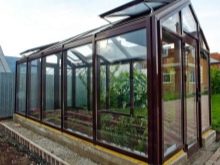
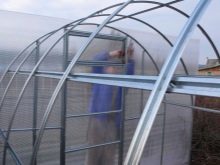
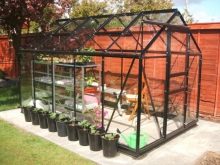
The aluminum case will serve you faithfully for a very long time. It does not need to be additionally painted or regularly coated with protective agents. Everyone knows the plasticity of this material, so it can be used to build a structure of almost any shape and size. Manufacturers offer already prepared elements that must be connected together in a certain sequence. The disadvantages include the high cost of an aluminum profile.
The galvanized profile is widely used for the manufacture of all kinds of greenhouses. Relative cheapness and ease of installation makes it a favorite in this segment. In stores, you can find ready-made kits for the construction of greenhouses. Craftsmen, on the other hand, have learned to use a galvanized profile designed for fastening drywall to create structures.
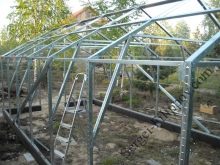
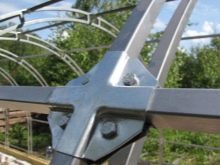

Covering material
Depending on the type and design of the greenhouse, polycarbonate, glass, film or spunbond can be used as a covering material.
For stationary structures, it is best to use polycarbonate, since it is flexible enough to take a semicircular shape, and durable. That is why most modern manufacturers prefer this particular material.
The thick film can be used as a covering material for small temporary structures. It is easy to pull it on a frame of any shape. But it should be borne in mind that you will have to constantly ventilate the greenhouse, since it does not allow air to pass through at all. With strong gusts of wind and a hurricane, such a structure can easily break or tear. Despite such disadvantages, it is still loved by many gardeners due to its low cost.
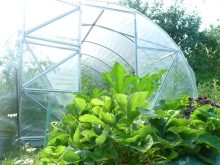
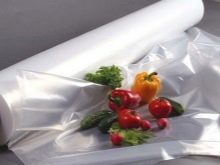
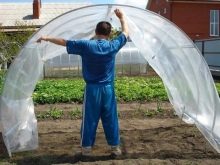
An alternative to the film can be made from spunbond or agrofiber. They pass air well, protect the seedlings from gusts of wind, cold and retain heat. At the same time, you should not worry that the plants will die due to overheating, as this can happen in the case of the film.
It is worth noting that agrofibre can also be used as a covering material that spreads directly onto the ground. This production technology is used by large agricultural complexes. This helps in weed control and provides additional protection for the sprouts. On a personal plot, they can cover the beds with Victoria. At the same time, it will not be necessary to constantly weed them, and the collection of berries will be much easier.
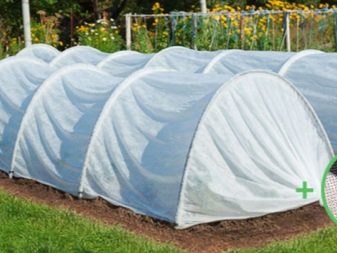
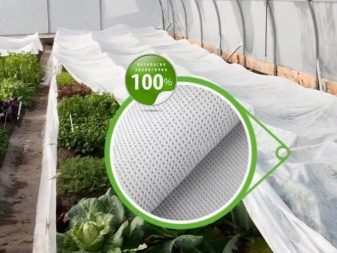
Even some 15-20 years ago, a glass greenhouse was considered a real luxury for a personal plot. But today manufacturers prefer more modern and practical materials. This is due to certain difficulties when working with it. Firstly, it is quite expensive. It is impossible to build an arched structure beloved by many from it. Also, glass is quite heavy and fragile, which complicates the installation process.
If you still prefer a glass structure, think over the ventilation system in advance. Otherwise, you will need to manually ventilate the greenhouse in the morning and evening. It should also be borne in mind that even a small child can break glass and the risk of injury is quite high.
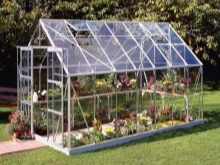
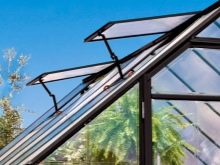
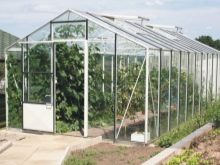
Forms and designs
When deciding to build a greenhouse at their summer cottage, most gardeners want it not only to be functional, but also to succinctly fit into the existing landscape. Manufacturers offer their customers various shapes and sizes of greenhouses. Therefore, if you wish, you can find exactly the one that will have an aesthetic appearance and will help to harvest a large harvest.
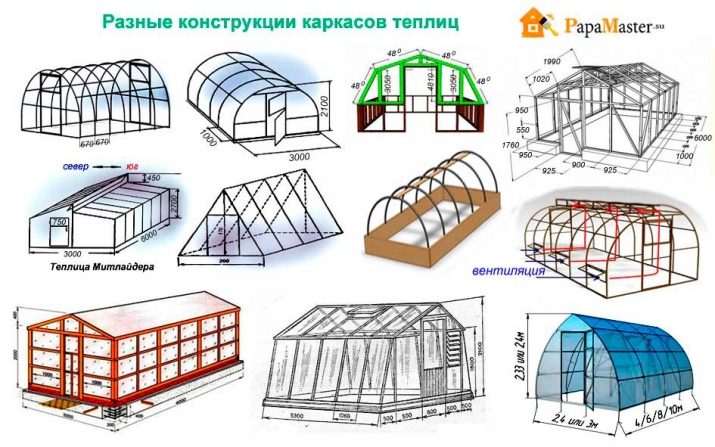
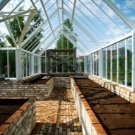
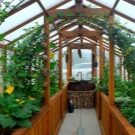


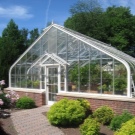
House shape
The frame for such a greenhouse can be made of either metal or wood. In homemade designs, the latter option is often used. Manufacturers, on the other hand, prefer more reliable and durable galvanized profiles.
This form is traditional and can be covered with any of the available materials. The only difference is the complexity of the installation. This form is very convenient, especially if you plan to install racks. One of the significant disadvantages is the high cost of the greenhouse.
A gable roof in this design has a clear advantage, since precipitation does not linger on the roof, but rolls down. And if rainwater can easily drain from other structures, then snow can linger on them. Here there is no threat of stagnation and breakage of the structure.
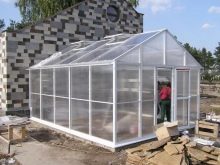
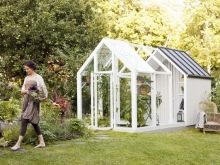
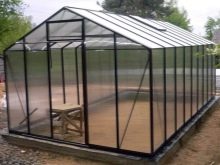
Trapezoidal
It is a kind of modification of the "house" shape. There are no significant differences between, especially if the walls are set at a vertical right angle. Another modification is a frame with walls inclined inward.
This option combines the advantages of a "house" and an arched structure. The plus is that the height of the greenhouse can be made slightly lower than that of the traditional gable structure. In this case, the base area will remain large enough. In addition, if desired, racks can be easily placed in it.
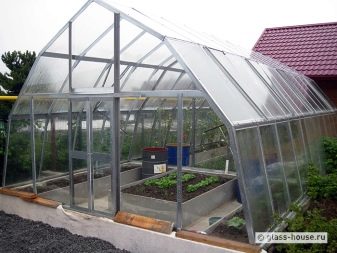
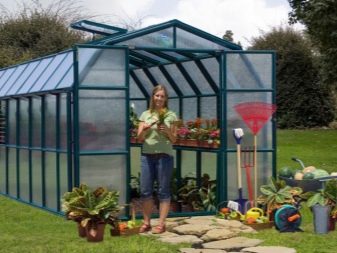
Hemisphere
Recently, this particular type of greenhouse has become the most popular. But making it in artisanal conditions without special tools is quite difficult.In order for the designs to serve you for a long time, it is better to give preference to ready-made models. Installation of such a complex shape is also not recommended to be done manually. Firms that provide this type of service give a guarantee for their work.
Do not think that an arched structure can only have the shape of a hemisphere. Some models have an almost round frame. It looks quite interesting against the background of other buildings and will certainly attract attention.
The disadvantages of such structures include the sudden appearance of cracks. This may be due to a long service life or increased stress on the upper base. In addition, you are unlikely to be able to arrange shelves and racks inside this space.
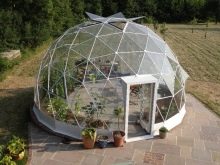
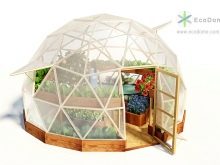

Pyramid
A pyramid-shaped frame with glass or polycarbonate inserts can be a real decoration for your site. So you don't have to hide it in your backyard. A competent designer will certainly tell you how to correctly fit it into the existing landscape.
If you decide to build such a structure yourself, then we advise you to consult with an architect. Here it is necessary to accurately calculate the permissible load.
If the frame is impressive in size, then to ensure the strength and reliability of the structure, it will be necessary to draw up a detailed drawing.
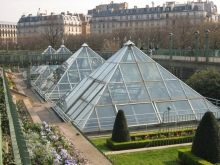

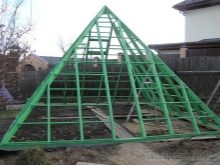
Mono-pitched
The second name of this design is wall-mounted. As the name suggests, the greenhouse has one slope and is mounted to the wall of a house or any other structure. Its main advantage is the saving of building materials, since, in fact, one wall is missing.
If you decide to give preference to this particular option, then you should take care of additional protection of the wall to which it will be attached. There is always high humidity inside the greenhouse, which can negatively affect the condition of the wall made of wood, concrete or brick.
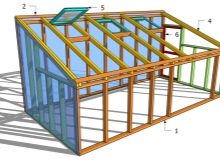
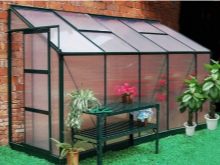
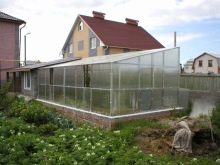
Greenhouse butterfly
Very comfortable and compact design. It is a tunnel about a meter high, covered with polycarbonate or foil. The peculiarity of its design lies in the fact that the flaps open from the bottom up like the wings of a butterfly.
The indisputable advantages also include a small height. This is due to the fact that there is no need to go inside. Access to crops is provided by opening the boards.
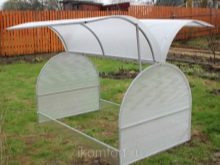

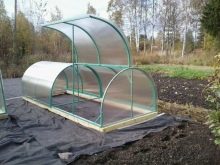
Dimensions (edit)
Greenhouses can be of absolutely any size, depending on the needs and wishes of the customer. It can be miniature structures covering one bed, and models 25 meters long. How to find the optimal size?
There are several important parameters to consider here.
- Price. Everything is simple here. The larger the size of the greenhouse, the more expensive its cost will be. If your family does not require a huge structure with an area of several hectares, then spending money on the purchase of a large greenhouse is inappropriate.
- Plot size. Happy owners of large plots can easily find a suitable place even for an impressive greenhouse. If you have a standard 6 acres, then you should not clutter them with a construction of 20 meters, especially if you like to come to the country with the whole family. Consider also leaving space for standard garden beds, a recreation area, and a place for children to play.
- Individual characteristics. If you and your loved ones have an average height and build, then it is quite possible to use the standard sizes of greenhouses. For people with problems with the musculoskeletal system and moving in wheelchairs, it will be necessary to provide for wider doorways.
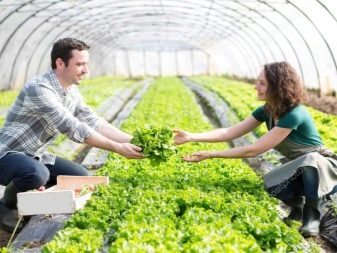
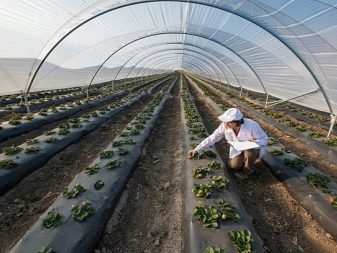
- Greenhouse shape. Rectangular structures can be of almost any length. The width is in most cases the standard value. For a greenhouse with two rows of beds and a passage, this value will be 2.5 meters, for greenhouses with 3 rows of beds from 3.5 m to 4.5 m.
- If you decide to install a greenhouse in the form of a pyramid or dome, then its size may vary depending on your wishes... Such designs are usually made to order, which affects their cost. However, with a well-executed installation, it can become a real decoration of the site, since it has a very attractive appearance.
- Crops grown. In some cases, you can get by with a low greenhouse type "bread box". It will not take up much space and will fit neatly into the available space. But this type is only suitable for low crops. In standard greenhouses (taller than human growth), both short and tall plants can comfortably be accommodated. At the same time, it is important to correctly place them inside the structure so that the sun's rays reach each of them.
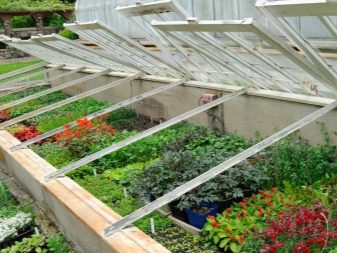
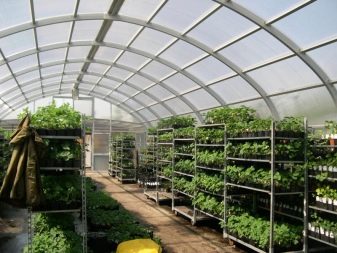
- Purpose. When growing crops on an industrial scale, it is not advisable to use small greenhouses. Their area can reach 5 hectares and more. If you do not want to spend all the time in the beds (even in an equipped greenhouse), you should not choose too large models. The optimal length is a greenhouse with a length of 4, 6 or 8 meters. It is in this size that most manufacturers produce them.
- Planting method. Even before buying a greenhouse, you should decide whether you will plant plants in the ground, pots or place them on special racks. This largely depends on the selected crops and their quantity. If you plan to place plants on racks of several floors, then consider the optimal height. The illumination of each individual sprout will depend on this, and, ultimately, the harvest.
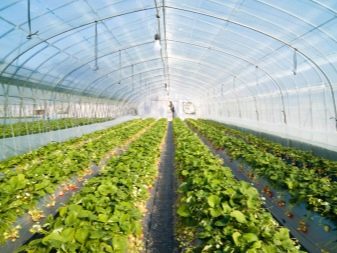
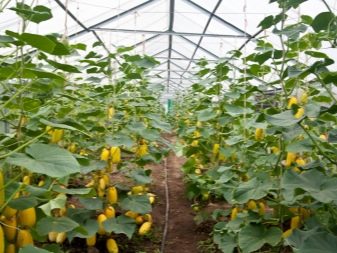
The standard greenhouse width is approximately 2.5 meters. This allows you to comfortably accommodate all landings and leave the passage. It will be necessary both when caring for crops and when harvesting. Often in permanent structures, it is concreted to avoid excess dirt and the spread of weeds.
The minimum greenhouse length is 125 cm. This is the size of the polycarbonate sheet. But in most cases, it turns out to be insufficient and summer residents choose more practical options with a length of 4 meters or more.
The height of a full-fledged standard greenhouse should be comfortable for an adult to be in it freely. As practice shows, a height of 2 - 2.2 m turns out to be convenient.
There is one more important feature to keep in mind. The larger the greenhouse, the more difficult it will be to achieve uniform heating. In this regard, it may be necessary to install a heating system, which will significantly increase its cost.


Optional equipment
The main purpose of any greenhouse is to get a good harvest even in the cold season. This can be facilitated not only by the design itself and the thermal insulation properties of the covering material, but also by additional equipment.
- Lighting. Of course, it is very convenient and practical to install conventional lighting in the greenhouse. For example, you don't have to walk with a flashlight early in the morning or in the evening. But you can also equip it with special lamps that will accelerate the germination and maturation of crops. We will not dwell in detail on the properties of various light spectra studied by lamps. Let's just say that some accelerate photosynthesis, others warm the soil well, etc. The following types of lamps can be distinguished from the variety that exists on the market at the moment: LED, fluorescent, infrared, high-pressure sodium lamps, mercury.
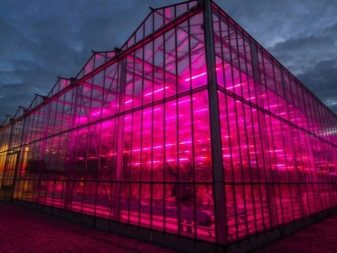
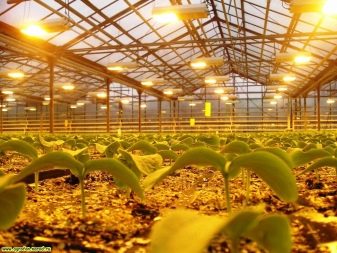
- Heating system. If you plan to grow crops all year round, you will need to take care of the heating. Without it, even the best greenhouse will be unsuitable for growing crops in the cold season. There are several options here: electric, stove, gas and steam.Each of them has its own pros and cons, so you need to choose one of the options taking into account individual characteristics and wishes.
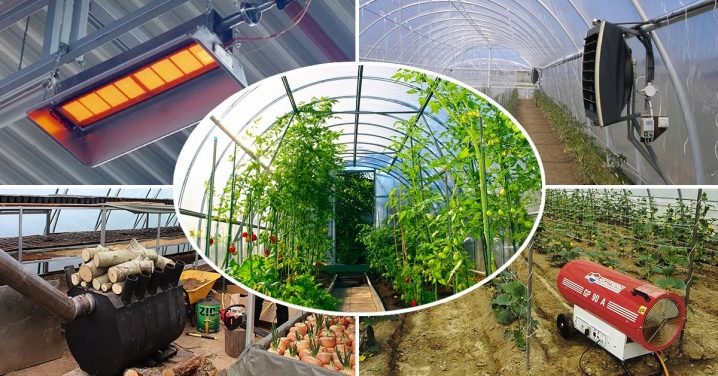
- Automatic watering. The automatic watering system makes life much easier for the gardener. One has only to program the system for a certain amount of watering per day and you can be calm that the plants will not dry out. This is very convenient if you do not live in the country all the time. Of the main disadvantages, it is possible to note the additional costs of installing such a system.
- Conditioning. Windows and doors are provided in various designs to ventilate the greenhouse. The whole question is whether you have to manually open and close them every morning and evening, or whether the automation will do everything for you. Be that as it may, plants, as well as all living things, need air, so do not forget to think over the air conditioning system even before installing the greenhouse frame.
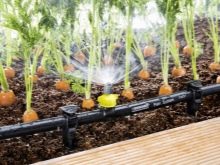
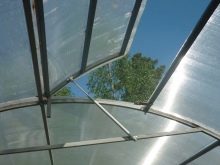
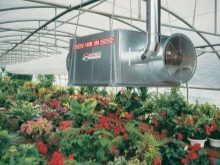
Advantages and disadvantages
When choosing a greenhouse, certain difficulties may arise. It is believed that polycarbonate greenhouses are the undisputed favorite at the moment. Still, do not discount other types of greenhouses. We have already analyzed the general concept of what characteristics each of them has. Let's try to summarize all the pros and cons of different types of greenhouses.
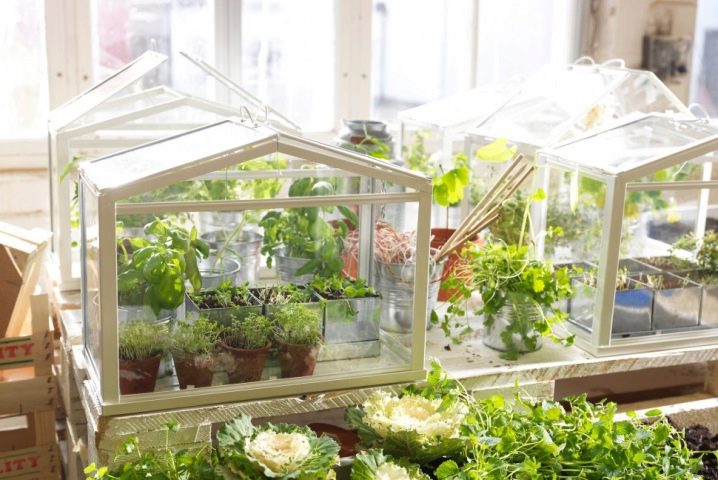
Film greenhouse
Advantages:
- Ease of operation.
- Easy dismantling. This may be needed not only after the end of the season, but also for intensive ventilation.
- There is no need to take care of snow removal from the greenhouse roof in winter.
- Affordable price. Of all its competitors, it has the lowest price, but it will also need to be changed every 2-3 years.
- Even if a hurricane turns the greenhouse upside down, the film will not break like glass into shards. Removing it from the site will not be difficult.
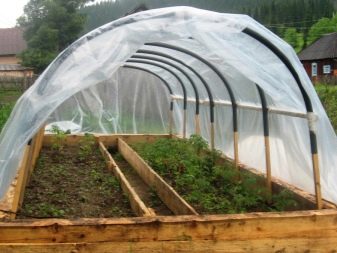

Disadvantages:
- The need to dismantle the structure for the winter. Although, on the other hand, this gives the soil the opportunity to be saturated with a sufficient amount of moisture in the spring. And the snow protects from freezing.
- Rapid wear and tear. This is the main problem with this material. Increased wind or hail can damage the coating and it will become unusable.
- It is possible to use ready-made film constructions only during the season. When frozen, it will not retain the necessary heat.
- Inability to use heating devices and systems. The film is highly flammable, so the installation of any electrical appliances is fraught with the risk of fire.
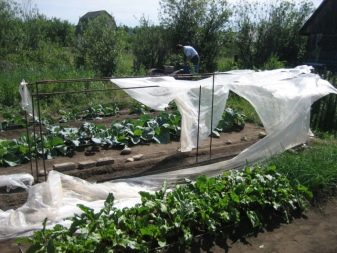

Glass greenhouse
Advantages:
- transmits light well;
- resistant to temperature extremes, humidity and frost;
- it is possible to install additional elements (lamps, heating, etc.);
- does not release toxins even at high temperatures;
- resistant to various types of chemicals that can be used to treat plants or soil;
- structural stability - a well-mounted greenhouse is not afraid of either strong wind or hail.
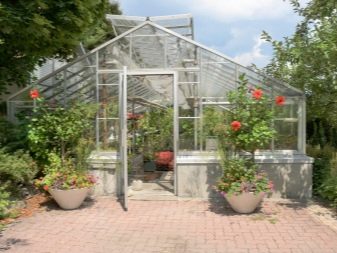
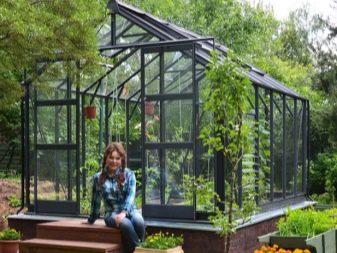
Disadvantages:
- fragility of the material;
- complexity of installation;
- the need for regular wet cleaning, otherwise the glass can become very dirty and it will be worse for the sun's rays to pass through;
- the large weight of the material itself requires a clear calculation of the maximum load on the supporting structure.
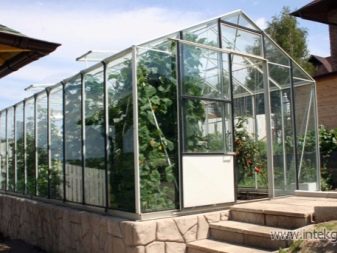
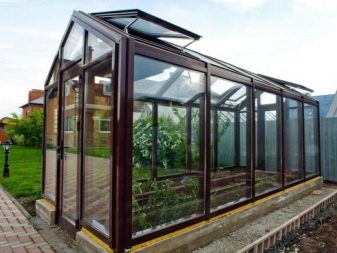
Polycarbonate greenhouse
Advantages:
- high resistance to mechanical stress and abrasive agents;
- good plasticity allows you to give it almost any desired shape;
- long service life - with proper care and protection, the greenhouse can last up to 20 years;
- resistance to the vagaries of the weather - she is not afraid of the bright sun, wind, rain, or even frost;
- high degree of protection against ultraviolet radiation;
- excellent thermal insulation performance;
- low probability of material ignition, which allows equipping it with complex electrical and other systems.
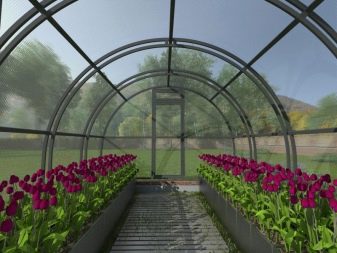
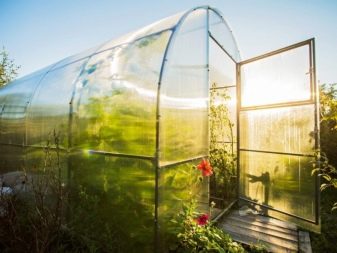
Disadvantages:
- high price;
- the impossibility of installing an arched structure without special tools and skills;
- the need to regularly remove snow in the winter;
- the need to fill the foundation.
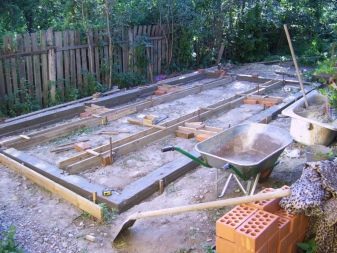
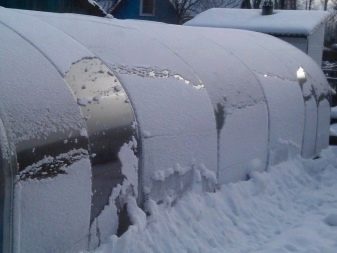
Manufacturers
Today there are a lot of manufacturers of polycarbonate greenhouses. In addition to the leaders of this segment known throughout Russia, each region has its own firms specializing in their manufacture.
When choosing, it is very important to know how the greenhouse will behave during operation. And it sometimes depends on many factors: on the quality of the polycarbonate itself, on the skill of the installation specialists, on the reliability of the frame and all the connecting elements. It's great if among your friends there are gardeners who have already acquired a greenhouse some time ago. You can ask them in detail about all the difficulties and shortcomings that they identified.
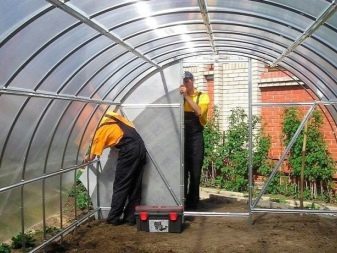
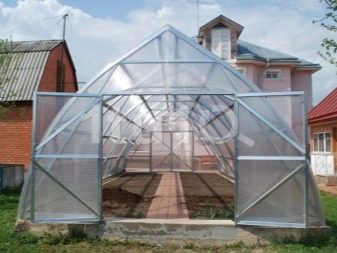
Here is a small list of manufacturers that have proven themselves in this market.
- Volia company. It produces one of the most popular and high-quality greenhouses - Strelka, as well as Treshka, Dvushka, Optima.
- "BashAgroPlast". Produces excellent arches, covering material and other components for greenhouses.
- "New Forms". The most popular model of this manufacturer is the Kremlin Lux greenhouse.
- TD "Harvest" and their greenhouse of the same name.
- LLC "Neftekamsk Mechanical Plant". Branches of the plant are located in 5 cities of Russia. Their greenhouse "Uralochka" is in the greatest demand.
Among other popular models that were not included in the list, one can note the greenhouses "Snail", "Zucchini", "Ogurchik", "Agronomist", "Accordion", "Dayas", which are already loved by many gardeners.
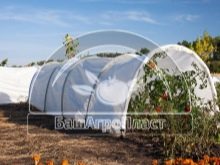
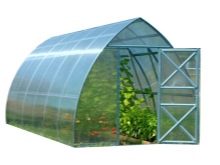
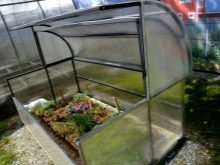
Selection Tips
- Decide on the purpose of the greenhouse. Whether it will be a large greenhouse that will house all the crops you need, or a small butterfly greenhouse.
- Decide if you need additional equipment. In most cases, high-quality greenhouses cope with their main task of keeping warm and accelerating the ripening of crops without additional heating (but not in winter).
- The choice of a specific model may also depend on where you are going to place the greenhouse, so even before buying, clearly draw on the plan where it will be mounted.
- Consider whether you need a permanent structure or if a temporary structure will suffice. For the first option, you will have to fill the foundation.
- Try to collect reviews from friends and acquaintances who already use this or that type of greenhouse.
- If you already have a certain amount of building materials (boards, metal pipes, etc.), then you should think about their active use in the construction of a greenhouse.
- The low price of the finished greenhouse should alert you. If it is polycarbonate, then it may be of poor quality and will not last you long.
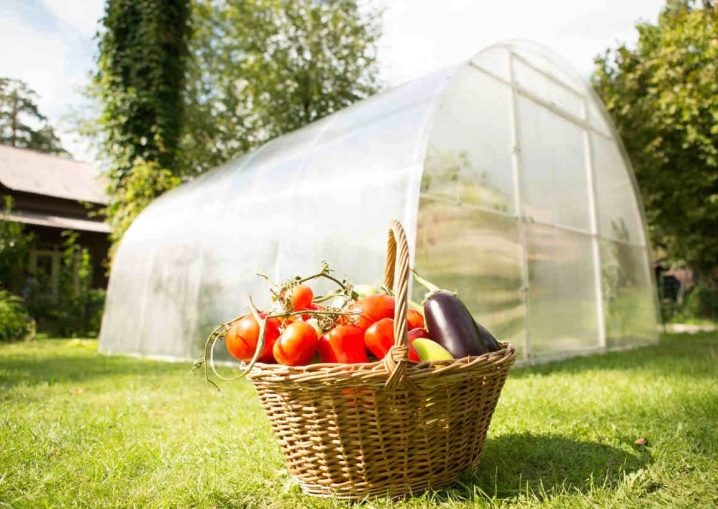
Best options
It is difficult to give universal advice on which greenhouse is better. It all depends on your requests and capabilities. You can install a super equipped greenhouse with automatic irrigation, heating and air conditioning systems on your site. But will it be rational to spend a lot of money if you are going to grow there only crops familiar to our climate, which feel great even without greenhouses?
But we can say with confidence that if you are not a “jack of all trades” and have never tried to make a greenhouse yourself, but there is such a need, then trust the professionals. Modern manufacturers offer high-quality and affordable options that do not require special agronomist skills from you, but at the same time will make it possible to get a rich harvest.
How to choose a greenhouse, see the video.





























































The comment was sent successfully.